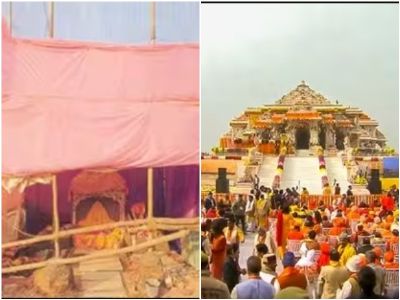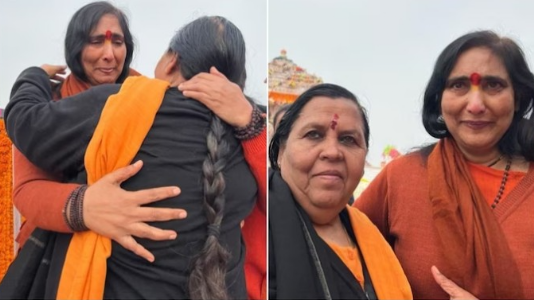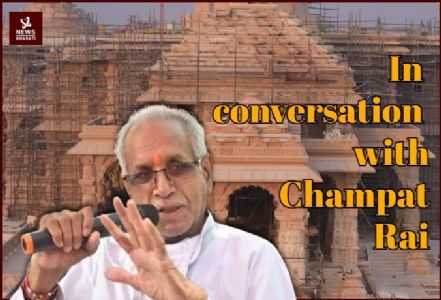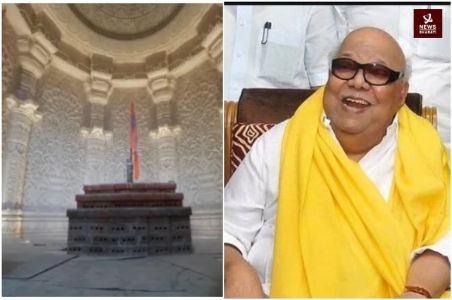Kalyan Singh Sacrificed Power & Made History in Ram Janmabhoomi Movement
Everybody agrees that ‘ifs’ and `buts’ have no place in history. This is a well-accepted idea as discussions based on ‘ifs’ and `buts’ cannot change the past. Still, it continues to be debated among the children and even among the academicians. On a serious note, one would agree that such discussions help us to understand the factors, which resulted in a particular incident. It helps us to understand other factors, including psychology, which shaped the course of history. It helps us to learn and unlearn ourselves, which is crucial in the decision-making process.
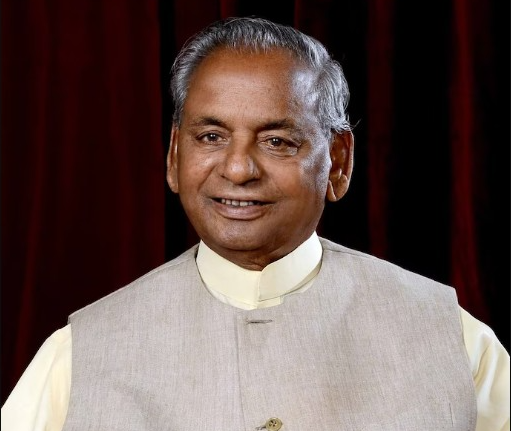
The most pertinent question in present days is – What would have happened if Kalyan Singh was not the Chief Minister of Uttar Pradesh at the time of the second Kar Sewa in 1992? Pulling down of the Babri structure, which was an outburst, was the most crucial turning point of the Ram Janma Bhoomi agitation. It was this moment, which paved the way for the construction of the Ram Temple in Ayodhya. Temple construction would not have been possible if the Babri structure continued to exist. It would have been a serious assault on ‘bhawvishwa’ of Hindus as the Babri structure was seen as a symbol of foreign invasion, which tried to crush Hindus with barbaric methods.
Kalyan Singh will always be remembered as one of the heroes of the Ram Janma Bhoomi agitation as his decision and role were decisive at the time of 1992 kar sewa. Being chief minister of Uttar Pradesh, Kalyan Singh could take an extreme decision- opening firing on kar sevaks – in 1992. Constitutionally, nobody would have asked for an explanation from him as law and order is the domain of state government. However, Kalyan Singh did not order firing as he was a staunch Hindu, having deep faith in Bhagwan Ram. Kalyan Singh must have felt that he would be committing the most serious crime against Hindus by taking such an extreme decision. Kalyan Singh must have felt that firing on kar sevaks would further complicate the struggle for Ram Janma Bhoomi, which was going on for more than five hundred years. Any extreme step by the then-UP government would have postponed temple construction for an indefinite period.
Imagine what kind of pressures Kalyan Singh would have been facing when thousands of kar sevaks were proceeding towards Ayodhya. Kar seva was not merely at the central point of national politics but had attracted international attention as well. Remember, he was the chief minister of Uttar Pradesh and not an ordinary party worker. Kalyan Singh was under heavy pressure to protect the Babri structure at any cost. The Uttar Pradesh government had submitted an affidavit to the Supreme Court, promising protection of the Babri structure. Kalyan Singh had also made a similar promise at the meeting of the National Integration Council (NIC). All political parties, excluding the BJP, were asking for stringent steps to protect the Babri structure. However, Kalyan Singh had his way, which was carved out of his conviction and commitment to the Hindu cause.
Kalyan Singh was an experienced politician and was well aware of the consequences of his decision. The results of the refusal to open fire on kar sevaks were multidimensional, including constitutional, political, and social. Kalyan Singh must be aware of the reality that he would be personally facing a serious case of contempt of court if anything happened to Babri's structure. However, nothing stopped him from remaining firm on his stand to not open fire on kar sevaks.
On the evening of December 6, 1992, Kalyan Singh simply stepped down from the post of chief minister, owing moral responsibility to what happened in Ayodhya. Kalyan Singh was not merely targeted for his decision but was cursed by hostile ecosystem but he was unmoved thanks to a commitment to ideology, which was above all political considerations. The choice before Kalyan Singh was very simple – either save the post of chief minister or save the lives of kar sevaks. He saved the lives of kar sevaks and did not bother about the post of chief minister. For him, political power was nothing before the emancipation of Ram Janma Bhoomi. This was the outcome of an unflinching commitment to the Hindu cause.
Kalyan Singh had never any regrets and repentance for his decision. He fully supported his own decision till the last breath. In an interview to an English newspaper, Kalyan Singh had said, “Maybe it was destined that the structure would be demolished with me as chief minister”. Kalyan Singh went on to say that had there been no demolition, probably the courts too would have ordered status quo.
Kalyan Singh’s determination was unimaginable. He was once asked whether he felt ashamed of demolition of the Babri structure. He simply replied, “Locking Ram Janma Bhoomi after independence was a national shame and not pulling down Babri structure”. He always used to have pride for saving the lives of Ram Bhaktas by refraining from opening fire. He never hesitated to say that the existence of Babri structure would have never made it possible to construct a temple at Ram Janma Bhoomi, once again an indicator of his deep faith in Bhagwan Ram. BJP old-timers remember that Kalyan Sing walked out with pride after submitting his resignation to the Governor and did not have any guilt on his face.
Apart from his role in the Ram Janma Bhoomi agitation, Kalyan Singh proved extremely helpful for BJP to expand its support base and cross traditional limitations. Kalyan Singh’s leadership emerged against the backdrop of Mandal agitation. Leftists tried to portray a picture of the struggle between `mandal and kamandal’. But little did they know that Kalyan Singh was a perfect combination of Mandal and Kamandal. His leadership emerged when Hindus were likely to be divided because of caste. Kalyan Singh played a crucial role in maintaining Hindu unity in the most populous and politically crucial state of Uttar Pradesh. His clout can be understood from the fact that he was the first BJP chief minister of Uttar Pradesh, which was not an easy task given the strong opponents like Mulayam Singh Yadav and Kanshi Ram. Kalyan Singh's leadership was instrumental in countering so-called social engineering by anti-Hindu political forces. This social engineering was nothing but putting castes against each other. But Kalyan Singh’s leadership curbed this trend, which had a long-standing effect on Indian politics.
Kalyan Singh was present when the Prime Minister performed shilanyas of Ram Janma Bhoomi temple on August 5, 2020. He was moved and emotional. He had then said that his only wish was to see Ram Janma Bhoomi temple. Unfortunately, Kalyan Singh will not be in Ayodhya for the historic moment of the consecration ceremony. But he will always be remembered for his role.
After the demise of Kalyan Singh, Prime Minister Narendra Modi offered his condolences saying, ‘Generations to come will remain forever grateful to Kalyan Singh for his contribution towards India’s cultural regeneration. Firmly rooted in Indian values and took pride in our centuries old traditions.
This was the most meaningful and fitting description of Kalyan Singh’s role as the country stands on the threshold of cultural regeneration.
Such questions are endless from the historical perspective.

The most pertinent question in present days is – What would have happened if Kalyan Singh was not the Chief Minister of Uttar Pradesh at the time of the second Kar Sewa in 1992? Pulling down of the Babri structure, which was an outburst, was the most crucial turning point of the Ram Janma Bhoomi agitation. It was this moment, which paved the way for the construction of the Ram Temple in Ayodhya. Temple construction would not have been possible if the Babri structure continued to exist. It would have been a serious assault on ‘bhawvishwa’ of Hindus as the Babri structure was seen as a symbol of foreign invasion, which tried to crush Hindus with barbaric methods.
Kalyan Singh will always be remembered as one of the heroes of the Ram Janma Bhoomi agitation as his decision and role were decisive at the time of 1992 kar sewa. Being chief minister of Uttar Pradesh, Kalyan Singh could take an extreme decision- opening firing on kar sevaks – in 1992. Constitutionally, nobody would have asked for an explanation from him as law and order is the domain of state government. However, Kalyan Singh did not order firing as he was a staunch Hindu, having deep faith in Bhagwan Ram. Kalyan Singh must have felt that he would be committing the most serious crime against Hindus by taking such an extreme decision. Kalyan Singh must have felt that firing on kar sevaks would further complicate the struggle for Ram Janma Bhoomi, which was going on for more than five hundred years. Any extreme step by the then-UP government would have postponed temple construction for an indefinite period.
Imagine what kind of pressures Kalyan Singh would have been facing when thousands of kar sevaks were proceeding towards Ayodhya. Kar seva was not merely at the central point of national politics but had attracted international attention as well. Remember, he was the chief minister of Uttar Pradesh and not an ordinary party worker. Kalyan Singh was under heavy pressure to protect the Babri structure at any cost. The Uttar Pradesh government had submitted an affidavit to the Supreme Court, promising protection of the Babri structure. Kalyan Singh had also made a similar promise at the meeting of the National Integration Council (NIC). All political parties, excluding the BJP, were asking for stringent steps to protect the Babri structure. However, Kalyan Singh had his way, which was carved out of his conviction and commitment to the Hindu cause.
Kalyan Singh was an experienced politician and was well aware of the consequences of his decision. The results of the refusal to open fire on kar sevaks were multidimensional, including constitutional, political, and social. Kalyan Singh must be aware of the reality that he would be personally facing a serious case of contempt of court if anything happened to Babri's structure. However, nothing stopped him from remaining firm on his stand to not open fire on kar sevaks.
On the evening of December 6, 1992, Kalyan Singh simply stepped down from the post of chief minister, owing moral responsibility to what happened in Ayodhya. Kalyan Singh was not merely targeted for his decision but was cursed by hostile ecosystem but he was unmoved thanks to a commitment to ideology, which was above all political considerations. The choice before Kalyan Singh was very simple – either save the post of chief minister or save the lives of kar sevaks. He saved the lives of kar sevaks and did not bother about the post of chief minister. For him, political power was nothing before the emancipation of Ram Janma Bhoomi. This was the outcome of an unflinching commitment to the Hindu cause.
Kalyan Singh had never any regrets and repentance for his decision. He fully supported his own decision till the last breath. In an interview to an English newspaper, Kalyan Singh had said, “Maybe it was destined that the structure would be demolished with me as chief minister”. Kalyan Singh went on to say that had there been no demolition, probably the courts too would have ordered status quo.
Kalyan Singh’s determination was unimaginable. He was once asked whether he felt ashamed of demolition of the Babri structure. He simply replied, “Locking Ram Janma Bhoomi after independence was a national shame and not pulling down Babri structure”. He always used to have pride for saving the lives of Ram Bhaktas by refraining from opening fire. He never hesitated to say that the existence of Babri structure would have never made it possible to construct a temple at Ram Janma Bhoomi, once again an indicator of his deep faith in Bhagwan Ram. BJP old-timers remember that Kalyan Sing walked out with pride after submitting his resignation to the Governor and did not have any guilt on his face.
Apart from his role in the Ram Janma Bhoomi agitation, Kalyan Singh proved extremely helpful for BJP to expand its support base and cross traditional limitations. Kalyan Singh’s leadership emerged against the backdrop of Mandal agitation. Leftists tried to portray a picture of the struggle between `mandal and kamandal’. But little did they know that Kalyan Singh was a perfect combination of Mandal and Kamandal. His leadership emerged when Hindus were likely to be divided because of caste. Kalyan Singh played a crucial role in maintaining Hindu unity in the most populous and politically crucial state of Uttar Pradesh. His clout can be understood from the fact that he was the first BJP chief minister of Uttar Pradesh, which was not an easy task given the strong opponents like Mulayam Singh Yadav and Kanshi Ram. Kalyan Singh's leadership was instrumental in countering so-called social engineering by anti-Hindu political forces. This social engineering was nothing but putting castes against each other. But Kalyan Singh’s leadership curbed this trend, which had a long-standing effect on Indian politics.
Kalyan Singh was present when the Prime Minister performed shilanyas of Ram Janma Bhoomi temple on August 5, 2020. He was moved and emotional. He had then said that his only wish was to see Ram Janma Bhoomi temple. Unfortunately, Kalyan Singh will not be in Ayodhya for the historic moment of the consecration ceremony. But he will always be remembered for his role.
After the demise of Kalyan Singh, Prime Minister Narendra Modi offered his condolences saying, ‘Generations to come will remain forever grateful to Kalyan Singh for his contribution towards India’s cultural regeneration. Firmly rooted in Indian values and took pride in our centuries old traditions.
This was the most meaningful and fitting description of Kalyan Singh’s role as the country stands on the threshold of cultural regeneration.
Total Views |




